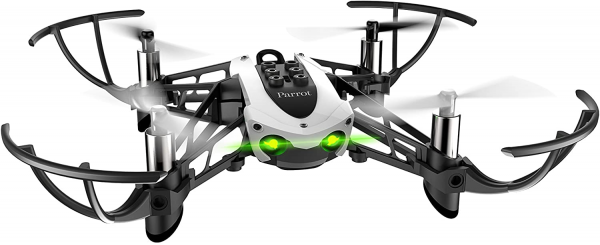Parrot
Parrot Mambo: immersion flight and drone races
Aprox. 50€
See specificationsThe cheapest of the range of Parrot drones is decidedly fun. The Mambo is intended for beginners who want to discover piloting with an evolving device and equipped with stabilization systems, but also have fun with its accessories.
Positive points
Easy to take in hand and pleasant to fly.
Several flight modes.
Flypad controller for more control (option on Mambo Fly).
Modularity.
Immersion flight.
Bad points
Disabling latency and video compression for fast flights.
Fairing that jumps too easily.
Improved stability, especially outdoors.
Noisy.
Our review
Presentation
The Parrot Mambo drone stands out for its modularity. We can thus add a clamp and a ball launcher (Mambo Mission pack) or even a camera (Mambo FPV pack) - the different packs are displayed in our price table above. In addition to the possibility of capturing photos and videos, the camera gives the device immersion flight capabilities when it is associated with the Parrot Cockpitglasses 2 mask - or other virtual reality mask for smartphones.
Those who just want a drone to fly on sight can be satisfied with the Mambo Fly, the "naked" version of the Mambo, sold at the recommended retail price of € 109 and simply including the drone, its battery, a USB cable and four hulls to protect the propellers. The Mambo Mission is displayed at 159 €, while the Mambo FPV is 179 €. Be careful however, without a camera, no video return is logically possible and the drone can only be controlled in direct view, which is not without consequence for the user experience, as we will see.
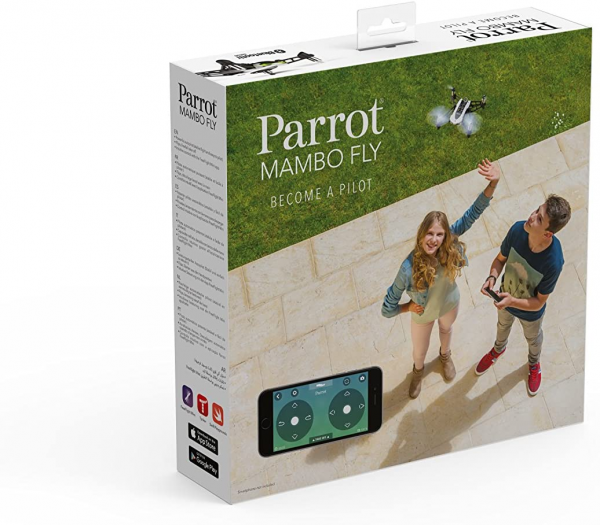
Getting started
But what is this funny black and white insect? With its two small diodes at the front arranged like a pair of eyes, the Parrot Mambo is distinguished from other drones by its small friendly face - it is however more reassuring with its eyes lit in green (sufficient battery level) than 'in red ( low battery or error). Quite compact, it fits into a 17.5 cm square with its fairing (15.2 cm without).
Although its structure is quite rigid, the flexible plastics of which it is composed do not necessarily reassure as to its robustness; the fine protection of the underside, in particular, bends and creaks all too easily if you pinch the drone to fix its modules. The Ryze / DJI Tello, for example, seems much more solid and better finished than this Mambo.
The Parrot drone is however lighter by almost 20 g compared to its competitor, displaying 69.5 g on the scale, battery and propeller protections included (65.1 g without fairing), although it is necessary to add the 10 g of its optional camera so that the comparison is really relevant. The Mambo thus gives more the impression of a toy than the Tello, but at least it does not mislead on its purely playful vocation.
However, we would have preferred that the propeller protections were better fixed to the arms of the drone, because they tend to come off far too easily in the event of an impact. At least we can easily remove them for outdoor use, to gain aerodynamics, weight and therefore maneuverability and autonomy.
The Mambo only works with a smartphone, via the FreeFlight Mini app. An application that has matured, but unfortunately still suffers from some bugs with some smartphones like our Huawei P8 with which it refuses to launch since the last update. No problem, however, with a Galaxy S6, for example, the stability of the link during our tests was irreproachable. It is therefore better to check that everything is working right after purchase, to have time to return the device in case of problems.
The connection is made directly via Bluetooth if there is no need for video feedback, or via Wi-Fi when the camera is installed. Buyers of the Mambo Fly - without camera or controller, therefore - must be content with touch controls, which are however sufficient for quiet flights, with assistance activated. The interface (screenshot below) then presents two virtual joysticks in the middle of the screen, the upper part being occupied by several buttons allowing access to the parameters, to take off or land the drone or to return to the home screen. An autonomy indicator is also displayed.
For more comfort and precision, however, you must opt for the Flypad, a Bluetooth controller sold separately or included in the Mission and FPV packs. Although it is quite rudimentary, this gamepad meets the needs for a mini-drone of this kind. Quite light and pleasant to take in hand despite a hard plastic construction, it gives access to several shortcuts and its two analog sticks allow you to control the drone (in mode 1, 2, 3 or 4 depending on our preferences for the position gas and roll, pitch and yaw). Its recharging is done simply by micro-USB and its integrated battery avoids having to worry about batteries. The good news is that the latency is low enough to enjoy healthy flying and the range is sufficient for visual flight at a good distance. Outdoors, without obstacle, we can control the drone up to several tens of meters: up to 100 m according to Parrot, a little less according to our tests, especially as the risk of losing sight of the device and to suffer a loss of connection becomes too important after the 50 m. In the absence of automatic return of the drone to its original position (no GPS) and of an audible signal to find it, we advise against playing with the limits in any case.
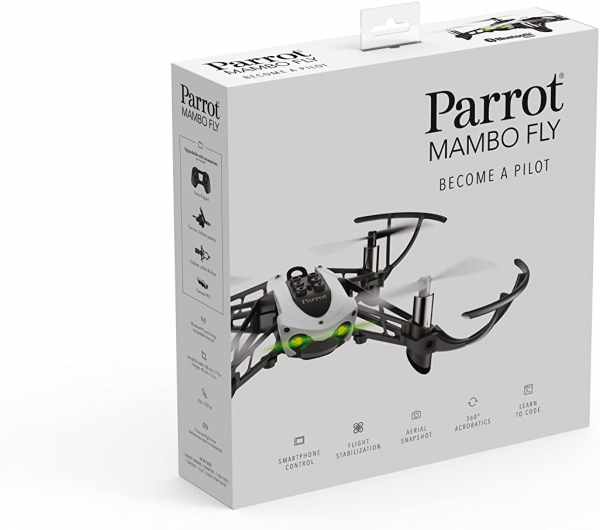
Flight
The Mambo takes off at the touch of a button and stabilizes about 1 m above the ground. You can also take it off from the hand by activating an option and launching it upwards. By default, the drone is stabilized horizontally and vertically, so that it hardly moves when the controls are released. This stability however reaches its limits outdoors if there is a little wind and it is better to keep the smartphone or the controller in hand to be ready to correct any drifts.
For more control, it is better to choose to fly in Drift mode with horizontal stabilization disabled or even in Race mode without any stabilization. Drone for beginners requires, it is necessary to do without "acro" mode which usually allows, on racer or freestyle oriented devices, to perform aerial figures manually and to pilot without any assistance (no overhaul of the drone).
In terms of noise pollution, the Mambo is unfortunately not the most discreet, generating a rather strident and therefore unpleasant noise. Nothing unusual for a mini drone, but be aware that it is not a device to use when someone listens to music or watches TV, for example.
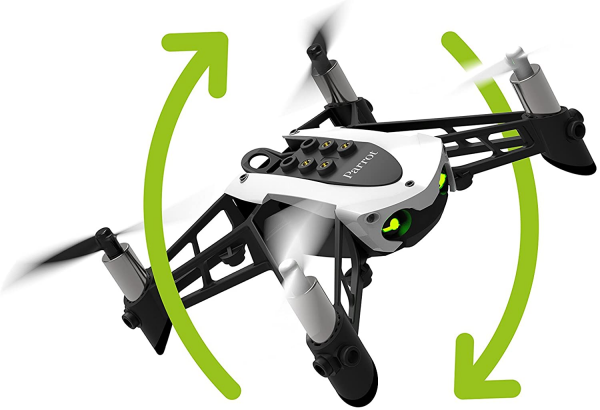
Image quality
The Mambo Fly does not include a front camera by default, it is only available as an option and sold with the FPV pack. The drone is however well equipped with a small camera on its belly, but it mainly serves to stabilize it by filming the ground at 60 fps. Its very low definition sensor nevertheless allows you to take a few photos in 640 x 480 px (around 60 KB per image in Jpeg), Parrot does not hesitate to indicate the possibility of taking selfies and saving them in the internal memory of the Mambo ( 31 MB available). The quality is so bad, however, that one wonders why there is such a result.
To take advantage of slightly more interesting video capabilities, you must therefore turn to the Mambo's optional Wi-Fi camera. It simply attaches like a children's play brick on top of the drone, four connectors ensuring its power and its connection to the device. A microSD card slot is provided on the back for direct recording of photos and videos. No miracle however, the videos are limited to 720p at 30 fps, which mainly allows us to record flights to keep a memory of our possible exploits - or crashes, it depends. Of course, we should not expect to capture beautiful panoramas, even with the dedicated video mode allowing fluidity of orders; a mini-drone is not made for that anyway. To give you an idea of the image quality, we nevertheless shot a small sequence, visible in the video below.
This camera is in fact mainly designed for immersion flight, that is to say to pilot while having the impression of being in the drone itself. To do this, insert your smartphone into the Cockpitglasses 2 mask - or other similar virtual reality mask for smartphones - after activating the "VR" mode in the FreeFlight Mini application. The mask incorporates two lenses with adjustable interpupillary distance, but the camera only filming with a single lens, the vision is not in 3D unlike what we can see in a classic virtual reality mask. It therefore takes a little time to adapt, especially to fully appreciate the distances, but this is common to almost all drones.
The video link is digital and done via Wi-Fi. If the image quality is fairly good when you fly slowly, it degrades quickly with speed and distance. We then observe a significant pixelation linked to video compression. We certainly keep a visible image rather than undergoing cuts and this allows us to continue to control the drone, but it is better to calm the game quickly and get closer to the smartphone so as not to risk losing the drone. Likewise, the latency is noticeable if you are used to the speed of an analog link in 5.8 GHz like that used for racing drones. As a direct consequence, if beginners can taste the sensations of piloting in immersion, there is no question of qualifying the Mambo as a drone made for racing. It lacks too much reactivity to slalom between close obstacles. Too bad, since the Mambo is otherwise lively enough and could have lent itself to the game of racing with a more reactive video link.
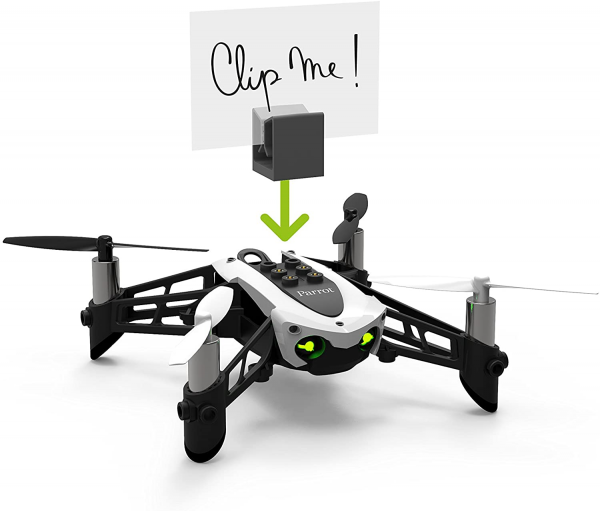
Autonomy
The Mambo in its Fly and Mission versions is supplied with a 550 mAh LiPo battery. Without camera, after 8 minutes of hovering indoors, the drone triggers an alert, its diodes then flashing in red until it ends up landing automatically when its battery runs out of energy, after 9 min 15 s. It then takes about thirty minutes to recharge your energy with a 2.4 A charger.
The FPV version comes with a 660 mAh battery to compensate for the increase in consumption due to the use of the camera. No miracle anyway, we lose 3 minutes of autonomy with it. This is logically less than the Tello which, thanks to its 1100 mAh battery, can last ten minutes - at the cost, on the other hand, of a softer behavior.
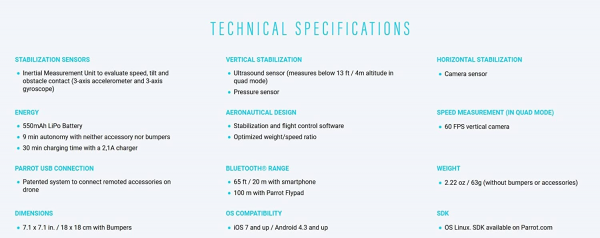
Conclusion
Ideal for beginners, the Mambo allows you to familiarize yourself gently with piloting a drone thanks to its deactivated assistance. However, it shows its limits when you start targeting the race because of the latency inherent in its Wi-Fi video link. However, there is still a mini-drone that is pleasant to fly, which is especially recommended in the FPV version. However, remove a star from the final note for the other versions, which are more limited due to the lack of a camera, and forget the Mambo if you already know how to fly and are looking for a really powerful drone.
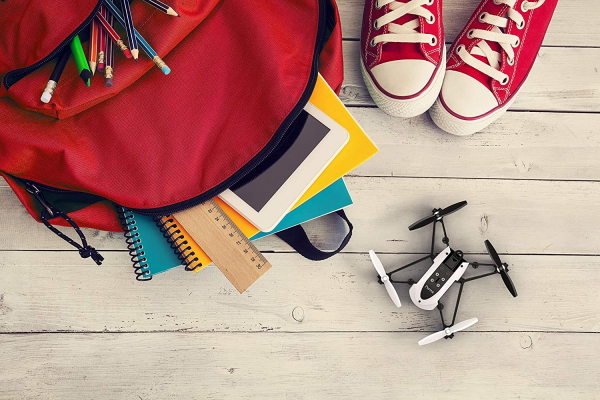
Specifications

